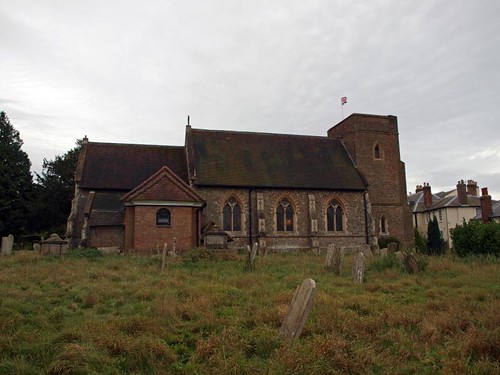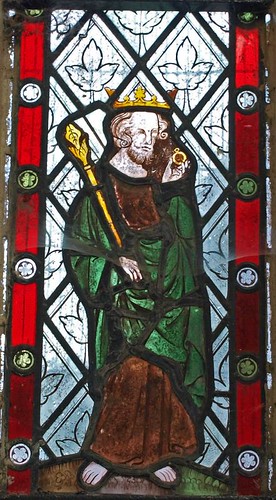ST MARY. Yellow brick W tower of 1815 and hideous church of 1862, by T. Jekyll of Norwich. The walls faced with a crazy-paving pattern. The windows with geometrical tracery. Nice small N chapel of brick, built in 1638. The windows, a remarkable fact, are round-arched and no longer Perp. - PULPIT. Nice late C16 piece with blank arches in the panels. - HELM in the N chapel, late C16. - STAINED GLASS. Very fine, small early C14 figure of Edward the Confessor (N vestry). - PLATE. Cup, Paten, larger Paten and Flagon, all of 1687; Almsdish of 1692. - MONUMENT. Sir John Abdy d. 1758. Standing wall monument with large putto standing by an oval medallion with frontal, rather vacant, portrait. Broken pediment on brackets at the top.
STAPLEFORD ABBOTS. Close to where the River Roding flows under the Ongar road is the slope of this village, where a lane leads us to a 19th century church with a brick tower and a 17th century chapel. There is elaborate 17th century carving on two chairs and a beautiful pulpit, and the 17 men and one boy who fell in the Great War are remembered by a marble panel of a vigorous St George killing a green dragon, and a window with a soldier trumpeter. But we must go into the vestry to see the finest window, a perfect example of 14th century glass showing Edward the Confessor with his sceptre and ring, his features and his divided beard exquisitely outlined in brown. In the chapel is some 17th century heraldic glass; a 16th century helmet painted with a cap of maintenance, the old badge of nobility; and a cherub holding a stone portrait in relief of Thomas Abdy, an 18th century lawyer. The Abdys were the great family here from 1650. A path across the fields and a stately avenue from the road leads to their old home of Albyns.
A brick house designed by Inigo Jones, it has in it part of the home built for Sir Thomas Edmondes, whose twelve volumes of diplomatic correspondence are an important source of Elizabethan history. The house is known for a wonderful staircase, carved with the Arts and the Virtues; for its panelling; and for its plaster ceilings. The transomed windows look out on to a square courtyard, and there is a gallery running 100 feet from bay to bay.
A brick house designed by Inigo Jones, it has in it part of the home built for Sir Thomas Edmondes, whose twelve volumes of diplomatic correspondence are an important source of Elizabethan history. The house is known for a wonderful staircase, carved with the Arts and the Virtues; for its panelling; and for its plaster ceilings. The transomed windows look out on to a square courtyard, and there is a gallery running 100 feet from bay to bay.


No comments:
Post a Comment